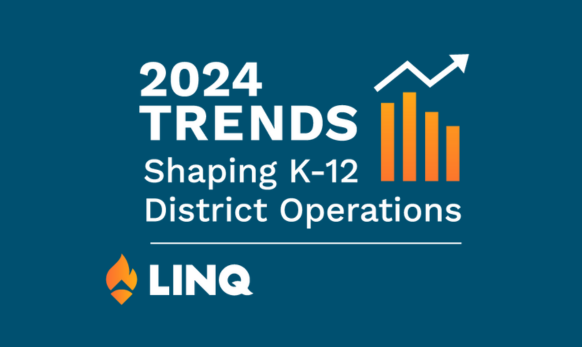The School Nutrition Association (SNA) just released their annual trends report for 2024, and it confirms a continuation of challenges that surfaced last summer in LINQ’s 2023 Nutrition Survey Report. Rising costs, staff shortages, and USDA’s meal pattern changes remain top-of-mind concerns for K-12 nutrition teams. Persistent supply chain disruptions and increasing student meal debt add to the complexity.
However, the news isn’t all bad. Districts are already finding innovative ways to alleviate these familiar challenges. Digging into SNA’s findings and analysis and reflecting on discussions with school and district nutrition leaders, 2024 could be a chance for many to turn the tide. Learning from successfully applied strategies, continuing to innovate with new ideas, and leveraging technology create opportunities for success.
Read on for a closer look at what SNA found in their survey results and how districts can take crucial action to address these challenges this year.
Takeaway #1: Rising Costs
Boosting efficiency will prove priceless against rising costs
Higher prices affect nearly everyone these days, but school nutrition programs shoulder more than their share of the weight. SNA found that 99.3% of survey respondents indicated moderate to significant challenges due to rising prices. In LINQ’S 2023 Nutrition survey, it was the top concern among all respondents.
It’s no wonder cost is a top-of-mind concern. Consumer Price Index (CPI) data showed a 296% increase in year-over-year school food prices in April 2023. That makes efficiency and cost reduction paramount in 2024.
It takes more than smart shopping—boosting operational efficiency means keeping close tabs on inventory, ensuring accuracy of purchase orders, reducing waste, and growing sales of popular items. An integrated front of house (FOH) and back of house (BOH) nutrition solution can help by automating much of this work and giving teams and leaders real-time, accurate information to drive decisions.
Check out this blog for tips to minimize kitchen waste and make efficiency gains:
Foolproof Ways to Reduce Food Waste in K-12 Cafeterias
Takeaway #2: Staff Shortages
Strengthening staff retention can help reduce growing shortages
Staffing nutrition teams is still a top concern. SNA found that 90.5% of school meal programs face moderate to significant challenges maintaining full teams. LINQ’s own study reflects two-pronged challenge of hiring and retaining enough staff. We found that districts with more than 2,000 students indicated higher confidence in recruiting and hiring but struggled more with retention over smaller districts.
Hiring and retention are two sides of the same coin. Districts struggling in one area can quickly see it affect the other. Long-term, districts stand a better chance of maintaining full teams if they can find balance between hiring and retention.
Nutrition leaders tell us that applying creative ways to build a strong team culture within their programs can have a big impact on retention. In turn, they say earning a reputation as a great place to work can significantly improve recruiting.
Get actionable tips for retaining valuable nutrition team members and making your district the place more qualified candidates want to work:
7 Ways to Retain Your Very Best School Food Service Employees
Takeaway #3: Menu Item Shortages
Flexibility is resiliency in the face of continuing supply chain disruptions
A sizeable 87.2% of respondents in SNA’s survey report challenges with procuring menu items. It’s a sure sign supply chain issues continue. Their data reinforces findings from our 2023 survey that at least one-quarter of food service leaders experienced difficulties sourcing specific items like meat, fruit, vegetables, and grains.
Supply shortages can lead to paying higher prices or planning alternate menu items. With costs already rising, accurate forecasting, ordering, and inventory matter more than ever. Additionally, it’s vital to maintain flexibility to adjust menus according to supply availability while ensuring compliance with USDA food requirements.
An integrated FOH and BOH nutrition system can automate purchasing so you can confidently manage your planning, ordering, and inventory process with greater accuracy. With real-time data at every step, adjustments can be made more easily when faced with sudden supply issues.
Get more tips for staying flexible and prepared for supply chain surprises:
K-12 Nutrition Supply Chain Woes: How to Plan for the Unexpected
Takeaway #4: Unpaid Meal Debt
Reducing meal debt requires innovative thinking
Unpaid meal debt doesn’t impact every district, but it’s increasing for those experiencing it. SNA reports that median unpaid meal debt increased another 5.8% annually in November 2023, continuing a trend going back to the 2014-15 school year.
It’s an increasingly difficult challenge for districts with the biggest struggles. 35% of food service leaders in our survey listed it as a top concern. However, SNA’s survey indicates that universal free meal programs virtually eliminated the concern for many districts in recent years.
Addressing meal debt without a free meal program means removing barriers to payment, maximizing meal reimbursements, and sourcing additional revenue to help cover the cost.
Here are five proven tips for helping to reduce unpaid K-12 meal debt:
Unpaid Meal Debt: How to Address the Elephant in the K-12 Lunchroom
Takeaway #5: Menu Changes
Meeting meal pattern changes with enticing options can increase participation
Menu changes are coming in accordance with the anticipated changes in USDA requirements. Almost 85% of respondents told SNA they’re seriously concerned about eliminating flavored milk for K-8, and another 84.2% expressed the same concern about additional sodium reductions. Grain-based dessert items and sugar-flavored yogurt and cereal also raise concerns for more than half of respondents.
Complying with the new meal patterns surely means menu changes for most districts. That presents a chance to shape new menu choices around student preferences. 66% of respondents in the SNA study said that student taste testing and sampling is their top choice for increasing acceptance of new menu options.
A quick digital form is a great way to incorporate student preferences into menu planning. A digital forms solution like LINQ Forms & Workflows offers a simple way to solicit opinions on new menu items or options students would like to see added.
Plan student-approved, healthy menus with tips from this blog:
Make Your Program the Upper Crust with Efficient Menu Planning
Start 2024 strong with fresh insight and proven K-12 nutrition strategies
K-12 nutrition professionals continue to show their dedication and innovative thinking. From adapting to ongoing change to delivering healthy meals to students even when schools were closed, they’re the heroes our communities deserve. The findings from SNA’s new report confirm that many of the challenges facing nutrition programs over the past few years continue to varying degrees. Now, school nutrition leaders can draw from the learnings successfully applied in other districts to form new strategies for embracing these challenges in the year ahead.
Join us for an exclusive look at more K-12 trends shaping district operations in 2024.
We’re kicking off the year with a series of four trend-focused webinars hosted by industry insiders and K-12 district leaders. Join us as we dive into strategies and approaches for addressing staffing shortages, building cybersecurity defenses, adapting to rising costs, and building resilience for a confident future in the constantly evolving K-12 environment.

